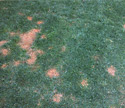
Dogs
Pets can cause a lot of damage to turf particularly in a small yard. A high concentration of dogs will wear out the turf as well as the urine will cause dead spots. There is no real way to cure this issue.

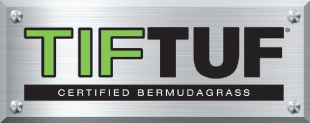
Here's the simple way to measure the area for the amount of sod you'll need:
1. Start by dividing the area to be sodded into squares, rectangles, and triangles, (as in the diagram above).
2. Figure the area of each shape.
3. Add the square footage of all areas to get 612 square feet, (144 + 360 + 108).
HINT: Add five to 10 percent to account for odd shaped areas and patch work around trees, bushes and other items in the area to be sodded. In the example above, you'd add about 60 square feet to your order!
TURF DISEASE PROBLEMS
Summer can be brutal on plants here in the desert, and there are a number of challenges we can have with our lawns.
If there are signs of pests or disease you'll need to know what you're up against and deal with it. Yellowing patches will be one sign, but may only indicate a watering issue. Lawn fungus is common here and has many faces, so let's look at that issue.

Dogs
Pets can cause a lot of damage to turf particularly in a small yard. A high concentration of dogs will wear out the turf as well as the urine will cause dead spots. There is no real way to cure this issue.
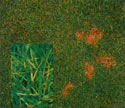
Dollar Spot
Prone to attack lawns during the hot dry season. The size of the damaged areas of grass will typically be about the size of a silver dollar.
The blades of grass will have pale beige lesions with red-brown borders. A faint cobweb type growth may be seen on the leaves. This is often more common when mowing is too frequent.

Summer Patch
May begin as small circular light brown patches that progress to larger patches. Weeds will typically begin growing in the dead patches. The color fades to yellow as the turf dies. When turf with summer patch is dug up, the roots are dark brown, hard and dry-rotted in contrast to the white color of healthy crowns and roots. Summer patch is so named because it will occur during extended hot weather and especially where there is poor drainage. Sound familiar?
Brown Patch
The leaves of the grass will have tan edges, and the patch size will be about 6 to 20 inches in diameter. Excessive nitrogen levels in the soil will contribute to the development of this disease as will night time watering. Proper cultural practices will generally prevent this from getting started in your lawn.
Pythium Blight
With this disease the spots turn from greasy to slimy before the grass dies out. This is the fungal disease that is easily spread by contaminated mowing equipment.
Fairy Ring
Not common, but important to recognize. This begins as circles on the lawns before it spreads, and ultimately produces poisonous mushrooms.
Control: Prevention is the best cure.
Mowing
Before you mow again, please have the blades sharpened and make sure they are adjusted properly. Set the mower high so that you don't cut more than an inch off. Sure, you'll be cutting a little more often, but grass can become stressed when too much is cut off at one time.
Cut about a third of the height each time. A three inch lawn goes down to two inches, and like that. Cutting a lawn too short might look nice at the time, but then it requires more watering and feeding which requires more mowing- and so we go.
Thatching
Fall is a good time to remove thatch buildup. If the thatch is 1/2 inch deep or more, it's time to remove it. For a small lawn, a thatch rake might be the most convenient tool for removing it, but if you have a larger lawn you'll likely want to get a de-thatching blade to put on your mower, or rent a dethatcher.
Q: How do I know I am receiving a turf that is suitable for my area?
A: Valley Sod uses the latest varieties of certified blue tag seed to insure the best quality turf. All varieties are tested to determine if they are adaptable to growing in our high desert conditions. The location of Valley Sod's growing grounds is just 45 minutes southwest of Las Vegas. This close proximity guarantees that sod is always freshly cut and grown in similar conditions to the Las Vegas valley.
Q: How do I decide between a cool season grass like fescue or Bermuda, a warm season grass?
A: Nevada is classified as a Transition Zone because of its mild seasonal climate. Cool season grasses grow faster in the spring and fall and slow down in the summer/winter. Most people prefer the look of a green yard all year round without having to overseed. Fescue will stay green during the winter if properly fertilized before late fall. Bermuda goes dormant in the winter and requires an overseeding of rye grass to keep the yard green.
Q: Can I put sod on top of existing grass that did not take or has died?
A: No. Fresh cut sod needs soil-to-soil contact. In other words, the existing sod or dead grass must be removed first. Sod roots must be in contact with soil or they will dry out. Level out soil where the old sod has been removed, add 2" of top soil to cover the old grass and soil amendments as recommended in our installation instructions, dampen the soil, sprinkle 16-20-0 fertilizer and then lay sod on top soil. Make sure there is soil-to-soil contact. Please note that if sod is laid over Bermuda grass it must be killed off entirely or there will be regrowth of the Bermuda in warm weather.
Q: What is the main cause of death of sod?
A: WATER! Either too little or too much water is the most common mistake that homeowners make when watering their newly installed lawn. Too little water will cause the sod to dry out and stress. Too much water can be worse over time causing roots to rot and sod to die. Watering schedules and times need to be adjusted to the time of year on established turf to keep it healthy.
Q: Why did the sod edges dry out after installation? Will it recover?
A: More than likely your sod will recover from dry edges. Sod needs to be installed so the edges are butted close together. Gaps will cause edges to dry out. Try to push sod pieces together to avoid gapping. Sod edges can dry out while sitting on the delivery pallet if not installed promptly. Weather and wind can also contribute to drying edges. Conscientious watering, time and patience should result in the regrowth of the damaged area.
Q: How soon can the lawn be mowed after installation?
A: As the grass is growing on top, the roots are growing on the bottom. Gently tug on the sod to see if it has rooted. This normally takes about two weeks. Do not let the grass get too long before mowing. Long grass can block sprinkler heads and create watering problems. Keep grass blades slightly longer in summer to shade roots.
Q: What about fertilizing new turf?
A: It is recommended to use a starter fertilizer such as 16-16-16, 15-15-15 or 16-20-0 at time of installation. Follow the directions on the bag for application rates. Use half the recommended amount on the soil before installation and the other half sprinkled on top of grass after installation.
Q: Should I aerate my yard and when should I do this?
A: Yes. Aerating is beneficial to keep your lawn healthy. Do this during the spring or fall when it is cooler approximately every 3-5 years depending on your lawns' condition. If your grass gets a lot of traffic you may need to do it more frequently.
Q: What fertilizer should I use depending on the time of year?
A: Please consult the chart below:
FOLLOW THESE GUIDELINES TO INSURE A HEALTHY AND BEAUTIFUL LAWN:
1. Rake out rocks larger than 3/4" from soil. The soil should be loose but firm. It is recommended to add organic matter to your soil like a soil conditioner, fine mulch or peat moss. Organic matter helps to keep soil loose and helps retain moisture. Work this into the soil approximately 2" to 4" deep using a tiller or landscape rake.
2. Test sprinkler system to make sure you have good head to head coverage. Check for blocked sprinkler heads, broken pipes, etc. Make all adjustments before and after laying sod.
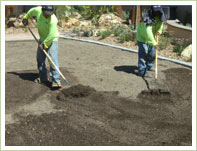 Raking mulch into top soil and
leveling the ground
Raking mulch into top soil and
leveling the ground
3. Rake 16-20-0 or 15-15-15 fertilizer into the top inch of soil. This helps the sod root faster. Follow directions on the bag for application rates.
4. Wet down the areas to be sodded and keep moist until the sod is laid. This will help to even out the top of the soil and remove air pockets. In summer, a dry base can cause sod to dehydrate, burn root hairs and stress it's system.
5. INSTALL SOD IMMEDIATELY UPON DELIVERY. IT IS A LIVING THING AND NEEDS WATER AND GROUND CONTACT TO SURVIVE.
6. Begin installing sod along the longest straight edge of your lawn. Push edges tightly against each other. Stagger joints in each row in a brick pattern. Avoid gaps or overlapping. On slopes, place sod across the slope. Sod can be easily cut to conform to curved boundaries, trees, etc., with a sharp knife. As you lay down a section of sod, water it with a hose. Keep sod moist at all times.
7. In hot weather, protect any unlaid sod by placing stacks in shade or covering with an old sheet and wetting it down with water. Water sod within 30 minutes of installation.
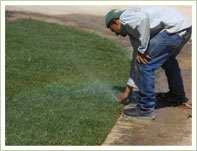 Adjust sprinklers after sod
installation for proper coverage
Adjust sprinklers after sod
installation for proper coverage
8. Avoid causing indentations or air pockets after laying sod. You should keep good sod to soil contact. Rolling the area after sod installation will help to do this, but is not required.
9. Remember, the roots of your new sod exist within the top 1/2" - 3/4" of soil. Until the roots are established, they will depend entirely on this thin layer for survival.
NOTE: You are exempt from the watering schedule published by the Las Vegas Water District for 30 days after new sod installation.
10. Weather conditions can greatly affect sod. Be sure your sod has enough moisture to survive hot, windy and dry conditions. Adjust watering schedule according to these conditions.
11. Hand water areas near buildings and curbing where reflected heat could dry out turf.
12. During the first 2 weeks of installation, avoid heavy or concentrated use of your new lawn. This gives the roots an opportunity to firmly knit with the soil and insures that the turf will remain smooth.
13. Mow as often as needed to remove 1/3rd of the leaf blade. Keep the lawn longer in the summer to reduce heat stress. Keep mower blades sharp.
14. For Fescue, fertilize your yard as needed to keep a rich green color. The lawn should be fertilized every 45 days in the spring and fall. Lesser amounts can be applied in the summer months but use caution. A high nitrogen fertilizer in the late fall insures a good green color throughout winter.
We offer sod installation services on jobs of 20,000 square feet or more, depending on availability.
Licensed landscape contractors can be referred to customers for smaller projects. Installations can be made by the pallet load or through the use of our big roll installer.
Phone orders are taken at our office in Las Vegas
Monday thru Friday from 8:00AM till 5:00PM PST
Shipments for next day delivery must be received by 11:00 a.m.
Orders can be placed by calling (702) 645-4070
Payments can be made directly to our sales office in Las Vegas or over the phone using VISA, MasterCard, American Express or DISCOVERY. All orders must be paid in advance of shipment
Valley Sod Office
3725 W. Teco Avenue, Suite 9
Las Vegas, Nevada 89118
